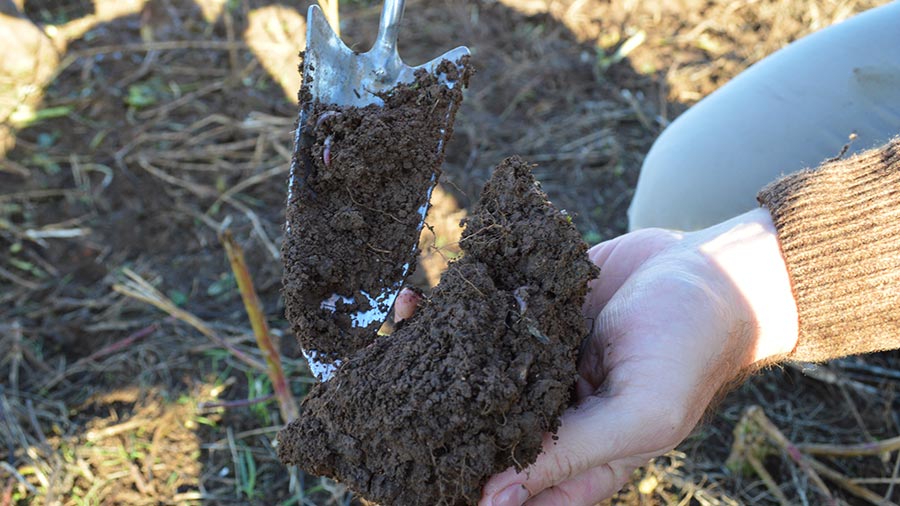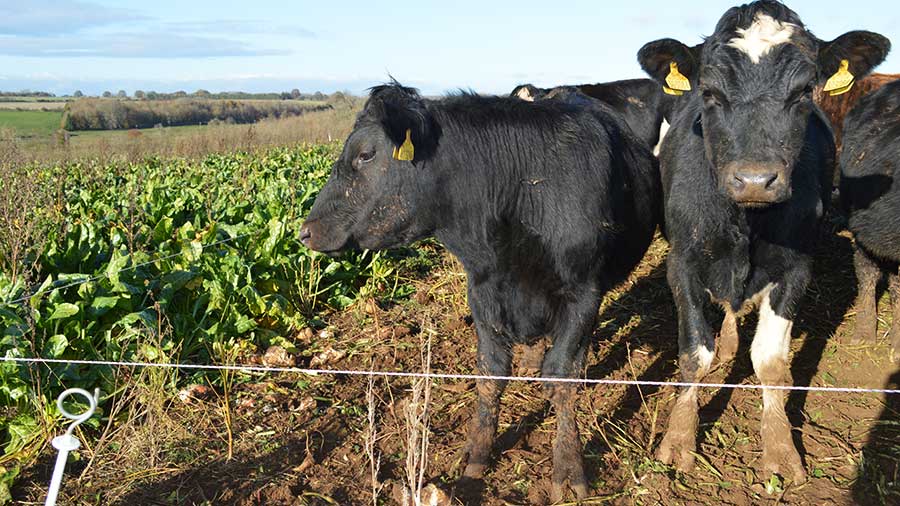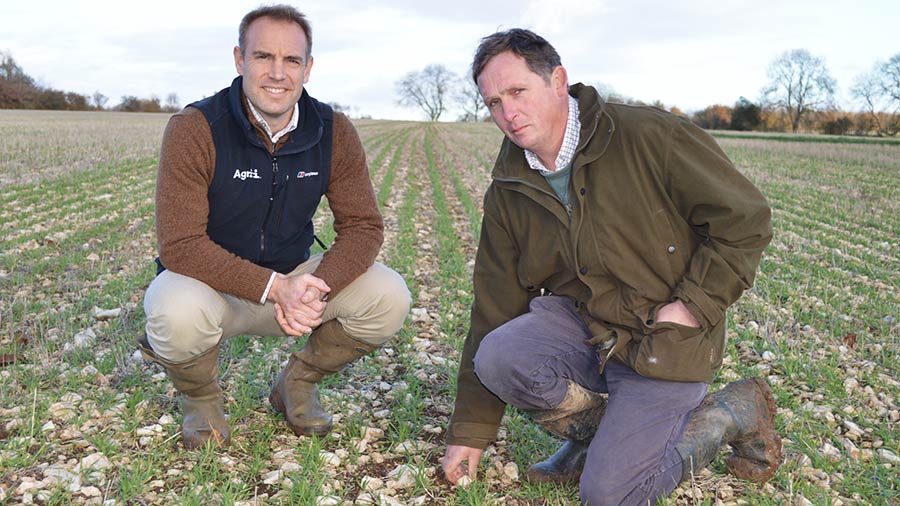Herbal leys bring fertility back to light Cotswold soils
 Toby Baxter's soil © MAG/David Jones
Toby Baxter's soil © MAG/David Jones Herbal leys are helping to return fertility to Toby Baxter’s light Cotswold limestone brashy soils, boosting his arable grain yields and allowing his livestock to thrive.
The diverse temporary grass mix helps him finish 4,000 lambs annually without using a single pellet of concentrate feed, and he can cut nitrogen fertiliser on his succeeding arable crops.
Mixing arable and livestock together on his stony marginal arable land has brought advantages to both sides, and he is now looking to finish beef cattle using grazed fodder beet and no compound feed.
“We are bringing fertility back into the ground, giving us a grassweed break and an uplift in yields on the arable side,” he tells Farmers Weekly.
See also: Farm manager’s drought action plan results in 15% yield lift
Farm facts
Chittlegrove, near Rendcomb, Gloucestershire
- Farming 3,380ha, including 1,380ha of arable and the rest grassland, on a range of soils including Cotswold brash, silty land and clay caps
- Arable – growing winter wheat, winter and spring barley, oilseed rape and triticale, plus catch and cover crops, and stubble turnips
- 4,200 ewe flock including Romneys, Llyen and EasyCare breeds, with numbers rising to 5,000 in spring 2021
- 360-strong beef enterprise and 70 Angus sucker cows and followers, plus recently taking over the management of a 250-strong dairy herd
Wheat yield lift
Mr Baxter says that winter wheat grown after a four-year herbal ley gives a 0.5t/ha yield lift, and he can cut his nitrogen fertiliser use by nearly a quarter on his 9t/ha wheat crops.
With Basic Payment Scheme (BPS) direct farm subsidies due to be phased out in the next few years, he believes a more mixed and sustainable farming system is more likely to survive in the future.
“If you remove the safety net of BPS, then there is a need for a more diverse farming business,” he adds.
Under an environmental Countryside Stewardship scheme, his landlords receive £309/ha for growing the herbal leys – but one drawback is they don’t start to grow quickly in the spring, as no nitrogen can be applied, so cover and fodder crops to feed the livestock are key.
Livestock help financially
After a tough arable year of a wet autumn, spring drought and then lower yields, the livestock has helped his farm financially, while adding fertility back to his thin stony soils, controlling blackgrass and improving yields.
“This year, livestock carried the business when arable yields were lower. Farming large-scale arable marginal land is unsustainable, so we need a more diverse mixed farm system with scale,” he adds.
So that is what he is doing, farming 3,380ha of Cotswold brash on a number of contract farming deals with a 4,200-ewe flock, 360 fattening beef animals and a 70-strong Angus sucker herd plus followers.
Mr Baxter’s farming operation, based at Chittlegrove, near Rendcomb, six miles north of Cirencester, covers a range of land within a 20-mile radius, growing cereals and oilseed rape, along with catch, cover and fodder crops.

Toby Baxter’s stock graze forage crops on the farm © MAG/David Jones
Create diversity
The herbal leys were introduced eight years ago to feed livestock and create diversity – and, with no need for any nitrogen fertiliser, they were like “feeding concentrates to lambs”.
He first started using the herbal leys to fatten store lambs in 3-4 weeks and finish 2,000 each year. As sheep numbers rose, he started to introduce forage and cover crops.
The herbal leys include ryegrass, cocksfoot and meadow fescue, legumes such as red and white clover, sainfoin, birdsfoot trefoil, plus plantain and chicory.
The latter is an especially strong rooting plant and helps with compacted soils. It also has anthelmintic properties encouraging livestock to expel parasitic worms. As such, no cattle are wormed on the farm and there is very low wormer use in lambs.
Return to arable
When the land is returned to arable, the herbal leys are sprayed off with glyphosate and then direct drilled using a 6m John Deere 750a with winter wheat or a seed crop of winter barley.
Early winter cereal drilling after grass is essential as the leys suck up nitrogen as the grass breaks down. Therefore, the winter cereals get off to a slow start before nitrogen is released in May/June the following year.
His agronomist, John Vickery – who works for agronomy company Agrii – says the herbal leys give an excellent entry back into cereals with grassweeds well under control.
“The big benefit of the herbal leys is that they allow us to drill early on these thin Cotswold soils in the latter half of September with few blackgrass or brome concerns,” says Mr Vickery.
A big financial benefit is the yield lift of 0.5t/ha on biscuit or soft feed winter wheats, while trimming nitrogen fertiliser usage.

John Vickery (left) and Toby Baxter (right) © MAG/David Jones
Nitrogen release
Mr Baxter points out that when growing winter cereals after grass, the nitrogen needs to be applied early in the spring before the big release in May/June. Rates on wheat after the herbal leys are cut to 140-150kg/ha from a more normal 180kg/ha.
“Nitrogen needs to be front loaded and be applied before big mineralisation kicks in during May/June,” he adds.
The nitrogen regime is typically 70kg/ha in early March, a further 50kg/ha in late April, and the final 20kg/ha on the flag-leaf stage in late May.
The land is normally in the arable rotation for five to six years, growing wheat, winter and spring barley, oilseed rape and triticale.
Nitrogen-hungry crops
The following crop after winter wheat is usually a nitrogen-hungry crop such as oilseed rape or stubble turnips for sheep feed. Mr Baxter is very keen not to leave any bare soils between arable crops, so catch and cover crops are very important.
His catch crops between two autumn-sown combinable crops consist of linseed, mustard, vetch and buckwheat, plus cover crops ahead of spring crops including forage rye, mustard, linseed and vetch.
After oilseed rape, he is quick to drill a mix of linseed, vetch and peas into the stubble. With 50kg/ha of nitrogen added, it produces a waste-high crop by the autumn to give good grazing for 1,000 ewe lambs.
Over the past five years, Mr Baxter is seeing the benefits of the herbal leys – as his land is easier to work, his drilling windows are extended, and there is less puddling and weed pressure.
With the vast range of crops – cereals, oilseed rape, catch and cover crops, and stubble turnips – there is an awful lot of drilling to do, so the farm operates the 6m 750a drill and an even wider 15m Amazone Condor tined drill.
Beef fattening
One further idea is to fatten dairy calves for beef using fodder beet to finish them, as herbal leys do not give enough energy.
He is growing 40ha of fodder beet and 40ha of fast-growing Westerwolds ryegrass. The beef cattle are given a fresh strip of beet every day with a fresh strip of ryegrass to fall back on, all behind electric fences.
After eight years of the more mixed farming approach, the land is looking in much better health and both the arable and livestock sides have gained.

